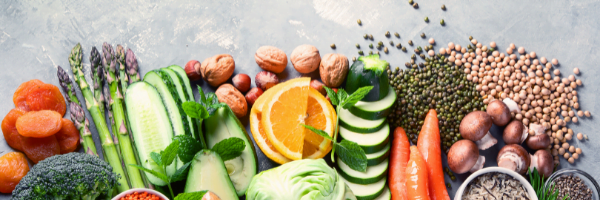The “USDA Organic” label is familiar to most shoppers, yet there is confusion about the definition of organic. And while many people purchase organic foods, others feel they can’t afford it. Still others think it doesn’t matter and is not worth the extra cost. While I do recommend organic foods, there are pitfalls in the buying process. It helps to better understand what organic really means and for which foods it really matters.
What Does Organic Mean?
Organic usually means free of most synthetic chemical inputs (e.g. fertilizer, pesticides, herbicides, antibiotics, hormones, and food additives), genetically modified organisms, and irradiation. The producer must keep detailed, written production and sales records, maintain strict physical separation of organic products from non-certified products, and undergo periodic on-site inspections.
The definition varies from country to country and, in the U.S., the National Organic Program (NOP) was enacted as federal legislation in October 2002. It restricts the use of the term “organic” to certified organic producers. Certification is handled by state, nonprofit and private agencies that have been approved by the U.S. Department of Agriculture (USDA).
Products made entirely with certified organic ingredients and methods can be labeled “100-percent organic,” while those with at least 95-percent organic ingredients can use the word “organic.” Both of these categories may display the USDA organic seal. A third category, containing a minimum of 70-percent organic ingredients, can be labeled “made with organic ingredients.” Products made with less than 70-percent organic ingredients cannot advertise this information to consumers and can only mention this fact in the product’s ingredient statement.
There is a bit of a loophole in the label, however, as the USDA has exempted 38 food ingredients that are just too difficult, at least currently, to supply as organic. As a result, these ingredients may be included under “organic” labels. Examples include hops, fish oil, sausage casings and some colorings.
The Dirty Dozen
Organic foods are usually higher priced and one needs to be smart about prioritizing when to spend on organic. Every year the Environmental Working Group puts together a list of foods particularly prone to chemical toxicity, known as the “dirty dozen.” In 2024, the list includes apples, pears, peaches, nectarines, strawberries, blueberries, grapes, cherries, green beans, sweet bell peppers and hot peppers, tomatoes, spinach and kale/mustard greens.
These are good foods to spend extra for organic as each of the “dirty dozen” typically hosts 10-20 detectable pesticides. Those imported from foreign countries tend to be the worst. Also, combine the dirty dozen with foods you eat frequently. For example, I eat berries, apples and greens daily so these are foods I prioritize as organic.
As the organic market has expanded to about four percent of the entire U.S. food market, the old days of hippie-gardener producers have been eclipsed by the need for commercial-scale production. Many popular, organic-labeled foods are produced by mega-conglomerate companies such as Coke, Pepsi, Nestle and Kellogg. Purists have decried this as a bad thing, but the reality of bringing large-scale organic produce to market demands large-scale production. Still, I like supporting the small producer, keeping the middle-man out of the equation, buying local and keeping more dollars closer to the actual producer.
Nutrition and Safety of Organic Foods
There is an old argument against organic, mostly from large, profit-driven companies such as Monsanto or Dow Chemicals, that organic production is not as efficient as the synthetic, chemical -supported agriculture. This complaint has been well refuted in large studies at the University of California at Davis and by the Rodale Institute, which show that organic farming is just as productive and more resistant to stressors such as drought, all the while using less fossil-fuel based energy. Rodale Institute Study
But is organic really healthier? Most studies show organic is about the same as conventional produced foods in vitamin and mineral content, but organic appears superior in concentration of healthy flavonoid compounds called polyphenols. NutritionFacts offers a good review. Numerous studies show improved animal health with organic feed sources and less pesticide exposure, but there is limited evidence of increased nutrition content per se.
According to the 2008 State of Science Review: Nutritional Superiority of Organic Foods, a review of more than 100 studies in the scientific literature, the “nutritional superiority of plant-based organic foods” was confirmed and the organic foods contained higher concentrations of important polyphenols and antioxidants. Meanwhile we have plenty of studies that link various pesticides to cancer, and recent research is showing genetically modified foods are linked to organ damage and higher rates of food allergies.
The Latest Research on Organic
Keep organic in perspective. The average American gets seven percent of total daily calories from the sugar in soft drinks — more calories than they are getting from fruits and vegetables! Clearly eating organic is relative if our diet is overloaded with sugar, high-glycemic carbohydrates and saturated fats that are driving inflammation, insulin and other unhealthy hormones.
Eating more plant-based foods and whole grains, combined with eating less processed and prepared foods, is a big step toward a healthier diet. It usually helps if you can buy local and choose whole foods in their raw unprocessed form.
Author
Scott Rollins, MD, is Board Certified with the American Board of Family Practice and the American Board of Anti-Aging and Regenerative Medicine. He specializes in bioidentical hormone replacement for men and women, thyroid and adrenal disorders, fibromyalgia and other complex medical conditions. He is founder and medical director of the Integrative Medicine Center of Western Colorado (www.imcwc.com) and Bellezza Laser Aesthetics (www.bellezzalaser.com). Call (970) 245-6911 for an appointment or more information.


